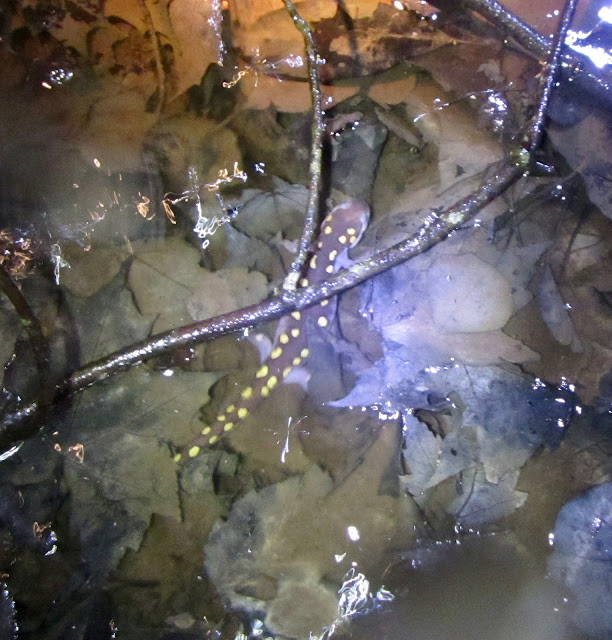 |
| A spotted salamander. |
Our region is home to many mole salamanders. Throughout the year, they burrow underground and are rarely seen. But in the spring, they emerge and head to vernal pools to mate. "Salamandering" is best done at night, venturing into wetlands to see what you can see.
Unfortunately, public land is often off-limits after dark. We had a chance to go salamandering at the Grand River Terraces in Ashtabula County with experts from the
Cleveland Museum of Natural History, and I definitely thought it was worth the effort to get there. The Cleveland Museum of Natural History owns about 30 nature preserves, and Grand River Terraces was one they purchased in the 1980s. All but 3 are closed to the public, and can only be visited with special permission or with a guided tour. My car thermometer read 70F as I left Pittsburgh, but snow had been predicted in Ashtabula. So we were relieved that it was well above freezing when we arrived. But it was still plenty cold, and very very rainy. It rained steadily the whole time we were there, and we were utterly soaked when we left. But that was perfect for amphibians, and we saw some amazing things!
Spotted salamanders, which are a striking combination of black with vivid yellow spots, were teeming in the waters. Jefferson salamanders were there in large numbers too, but with better camouflage, and we even found a red-spotted newt. The air was filled with the songs of midland chorus frogs, wood frogs, and spring peepers.
Our guides explained that the females lay their eggs, the males lay their spermatophores, and then it's generally up to the males to convince a female that they are the one whose spermatophores she should take to her eggs. Sometimes the males crowding in on a single female are enough to crush her. Sometimes the females just don't want to deal, and they find a spermatophore on their own. The trouble is that they may choose a spermatophore of the wrong species, and the resulting offspring are hybrids. All the offspring in this case will usually be females, although sometimes there can be a sterile male. The parents have 2 pairs of chromosomes, but the offspring can have 2, 3, 4 or even 5 chromosomes. These hybrids lay eggs, and the eggs can be viable, although the odds are diminished
. They need a spermatophore in order to stimulate development of their eggs. But the spermatophores might not make a genetic contribution to the offspring, who will be clones of the mother. Or they might add another set of chromosomes to the next generation of hybrids.
 |
| Spotted salamander egg mass. These are newly laid eggs, and the embryos still have a spherical appearance with few features visible. |
 |
| This leaf has tiny, white, mushroom-like spermatophores on it. |
 |
| Spotted salamander. They placed them in glass jars with water so that we could see them without touching them and messing with their delicate skin. |
 |
| Spring peeper. |
 |
| Jefferson/spotted hybrid. |
 |
| Hybrid eggs. These particular eggs are not viable. |
 |
| Spotted salamander. |
 |
| One scoop and all these spotted salamanders were caught! |
 |
| Red-spotted newt. These salamanders lay eggs singly, so we did not attempt to find their eggs. |












Comments
Post a Comment
Hello! I love to read your comments, but please be aware that they are moderated. This will result in a delay before they are posted. Thank you for your patience.